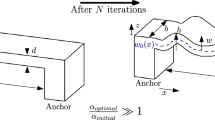Abstract
This paper deals with topology optimization of large-scale structures with proportional damping subjected to harmonic excitations. A combined method (CM) of modal superposition with model order reduction (MOR) for harmonic response analysis is introduced. In the method, only the modes corresponding to a frequency range which is a little bigger than that of interest are used for modal superposition, the contribution of unknown higher modes is complemented by a MOR technique. Objective functions are the integral of dynamic compliance of a structure, and that of displacement amplitude of a certain user-defined degree of freedom in the structure, over a range of interested frequencies. The adjoint variable method is applied to analyze sensitivities of objective functions and the accuracy of the sensitivity analyses can also be ensured by CM. Topology optimization procedure is illustrated by three examples. It is shown that the topology optimization based on CM not only remarkably reduce CPU time, but also ensure accuracy of results.


















Similar content being viewed by others
References
Bathe K-J (2013) The subspace iteration method – revisited. Comput Struct 126:177–183
Bathe K-J (2014) Finite Element Procedures, second ed. Prentice Hall, Watertown
Bendsøe MP, Kikuchi N (1988) Generating optimal topologies in structural design using a homogenization method. Comput Methods Appl Mech Eng 71:197–224
Bendsøe MP, Sigmund O (2004). Topology Optimization: theory, methods, and applications, second ed. Springer, Berlin
Deaton JD, Grandhi RV (2014) A survey of structural and multidisciplinary continuum topology optimization: post 2000. Struct Multidiscip Optim 49:1–38
Díaz AR, Kikuchi N (1992) Solutions to shape and topology eigenvalue optimization problems using a homogenization method. Int J Numer Methods Eng 35:1487–1502
Dickens JM, Nakagawa JM, Wittbrodt MJ (1997) A critique of mode acceleration and modal truncation augmentation methods for modal response analysis. Comput Struct 62:985–998
Du J, Olhoff N (2007) Topological design of freely vibrating continuum structures for maximum values of simple and multiple eigenfrequencies and frequency gaps. Struct Multidiscip Optim 34:91–110
Golub GH, Van Loan CF (2013). Matrix Computations, forth ed. Johns Hopkins University Press, Baltimore
Grimes RG, Lewis JG, Simon HD (1994) A shifted block Lanczos algorithm for solving sparse symmetric generalized eigenproblems. SIAM J Matrix Anal Appl 15:228–272
Haftka RT, Gürdal Z (1992). Elements of Structural Optimization, third ed. Kluwer, Dordrecht
Jensen JS (2007) Topology optimization of dynamics problems with Padé approximants. Int J Numer Methods Eng 72:1605–1630
Jog CS (2002) Topology design of structures subjected to periodic loading. J Sound Vib 253:687–709
Kang Z, Zhang XP, Jiang SG, Cheng GD (2012) On topology optimization of damping layer in shell structures under harmonic excitations. Struct Multidiscip Optim 46:51–67
Liu H, Zhang WH, Gao T (2015) A comparative study of dynamic analysis methods for structural topology optimization under harmonic force excitations. Struct Multidiscip Optim 51:1321–1333
Ma ZD, Kikuchi N, Cheng HC (1995) Topological design for vibrating structures. Comput Methods Appl Mech Eng 121:259–280
Olhoff N, Du J (2005) Topological design of continuum structures subjected to forced vibration. Proceedings of 6th world congresses of structural and multidisciplinary optimization, Rio de Janeiro, Brazil
Pedersen NL (2000) Maximization of eigenvalues using topology optimization. Struct Multidiscip Optim 20:2–11
Shu L, Wang MY, Fang ZD, Ma ZD, Wei P (2011) Level set based structural topology optimization for minimizing frequency response. J Sound Vib 330:5820–5834
Sigmund O (1997) On the Design of Compliant Mechanisms Using Topology Optimization. Mech Struct Mach 25:493–524
Svanberg K (2002) A class of globally convergent optimization methods based on conservative convex separable approximations. SIAM J Optim 12:555–573
Tcherniak D (2002) Topology optimization of resonating structures using SIMP method. Int J Numer Methods Eng 54:1605–1622
Wu BS, Yang ST, Li ZG, Zheng SP (2015a) A preconditioned conjugate gradient method for computing eigenvector derivatives with distinct and repeated eigenvalues. Mech Syst Signal Process 50:249–259
Wu BS, Yang ST, Li ZG, Zheng SP (2015b) A combined method for computing frequency responses of proportionally damped systems. Mech Syst Signal Process 60-61:535–546
Wu BS, Yang ST, Li ZG (2016) An algorithm for solving frequency responses of a system with Rayleigh damping. Arch Appl Mech 86:1231–1245
Yoon GH (2010) Structural topology optimization for frequency response problem using model reduction schemes. Comput Methods Appl Mech Eng 199:1744–1763
Yu Y, Jang IG, Kwak BM (2013) Topology optimization for a frequency response and its application to a violin bridge. Struct Multidiscip Optim 48:627–636
Zhao JP, Wang CJ (2016) Dynamic response topology optimization in the time domain using model reduction method. Struct Multidiscip Optim 53:101–114
Zhu JH, Beckers P, Zhang WH (2010) On the multi-component layout design with inertial force. J Comput Appl Math 234:2222–2230
Zhu JH, He F, Liu T, Zhang WH (2017) Structural topology optimization under harmonic base acceleration excitations. Struct Multidiscip Optim. https://doi.org/10.1007/s00158-017-1795-0
Acknowledgments
The authors are grateful to Krister Svanberg for providing the Matlab code of GCMMA optimizer. The work was supported by the National Natural Science Foundation of China (Grant No. 11672118).
Author information
Authors and Affiliations
Corresponding author
Rights and permissions
About this article
Cite this article
Zhao, X., Wu, B., Li, Z. et al. A method for topology optimization of structures under harmonic excitations. Struct Multidisc Optim 58, 475–487 (2018). https://doi.org/10.1007/s00158-018-1898-2
Received:
Revised:
Accepted:
Published:
Issue Date:
DOI: https://doi.org/10.1007/s00158-018-1898-2




